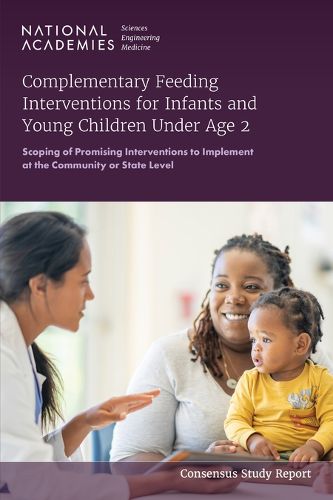Readings Newsletter
Become a Readings Member to make your shopping experience even easier.
Sign in or sign up for free!
You’re not far away from qualifying for FREE standard shipping within Australia
You’ve qualified for FREE standard shipping within Australia
The cart is loading…






Complementary feeding refers to the introduction of foods other than human milk or formula to an infants diet. In response to a request from the Centers for Disease Control and Prevention, the National Academies Health and Medicine Division convened the Committee on Complementary Feeding Interventions for Infants and Young Children under Age 2 to conduct a consensus study scoping review of peer-reviewed literature and other publicly available information on interventions addressing complementary feeding of infants and young children. The interventions studied took place in the U.S. and other high-income country health care systems; early care and education settings; university cooperative extension programs; the Special Supplemental Nutrition Program for Women, Infants, and Children (WIC); home visiting programs; and other settings. This consensus study report summarizes evidence and provides information on interventions that could be scaled up or implemented at a community or state level.
Table of Contents
Front Matter Summary 1 Introduction 2 Methodological Approach 3 Considerations 4 Overview of Interventions Identified in the Scoping Review 5 Identified Informative Studies and Elements 6 Considerations for Scaling Infant and Young Child Feeding Interventions 7 Implications and Considerations for Design of Interventions to Improve Infant and Young Child Feeding Behavior in the United States Appendix A: Committee Member Biographies Appendix B: Open Session Materials Appendix C: Literature Search Strategies and Results Appendix D: Data Extraction Criteria Appendix E: Data Extraction Tables Appendix F: Scalability Assessments for Informative Studies
$9.00 standard shipping within Australia
FREE standard shipping within Australia for orders over $100.00
Express & International shipping calculated at checkout
Complementary feeding refers to the introduction of foods other than human milk or formula to an infants diet. In response to a request from the Centers for Disease Control and Prevention, the National Academies Health and Medicine Division convened the Committee on Complementary Feeding Interventions for Infants and Young Children under Age 2 to conduct a consensus study scoping review of peer-reviewed literature and other publicly available information on interventions addressing complementary feeding of infants and young children. The interventions studied took place in the U.S. and other high-income country health care systems; early care and education settings; university cooperative extension programs; the Special Supplemental Nutrition Program for Women, Infants, and Children (WIC); home visiting programs; and other settings. This consensus study report summarizes evidence and provides information on interventions that could be scaled up or implemented at a community or state level.
Table of Contents
Front Matter Summary 1 Introduction 2 Methodological Approach 3 Considerations 4 Overview of Interventions Identified in the Scoping Review 5 Identified Informative Studies and Elements 6 Considerations for Scaling Infant and Young Child Feeding Interventions 7 Implications and Considerations for Design of Interventions to Improve Infant and Young Child Feeding Behavior in the United States Appendix A: Committee Member Biographies Appendix B: Open Session Materials Appendix C: Literature Search Strategies and Results Appendix D: Data Extraction Criteria Appendix E: Data Extraction Tables Appendix F: Scalability Assessments for Informative Studies